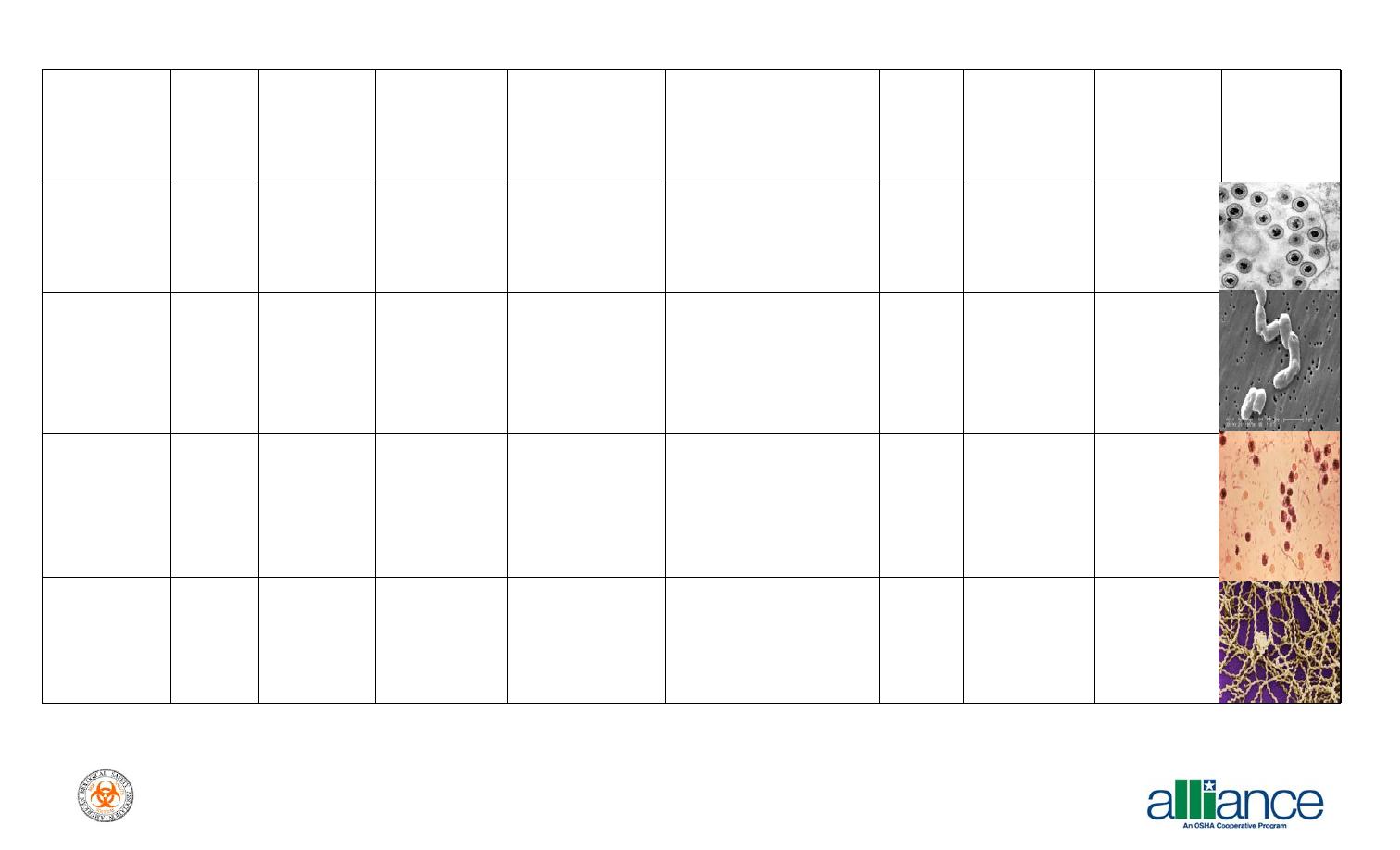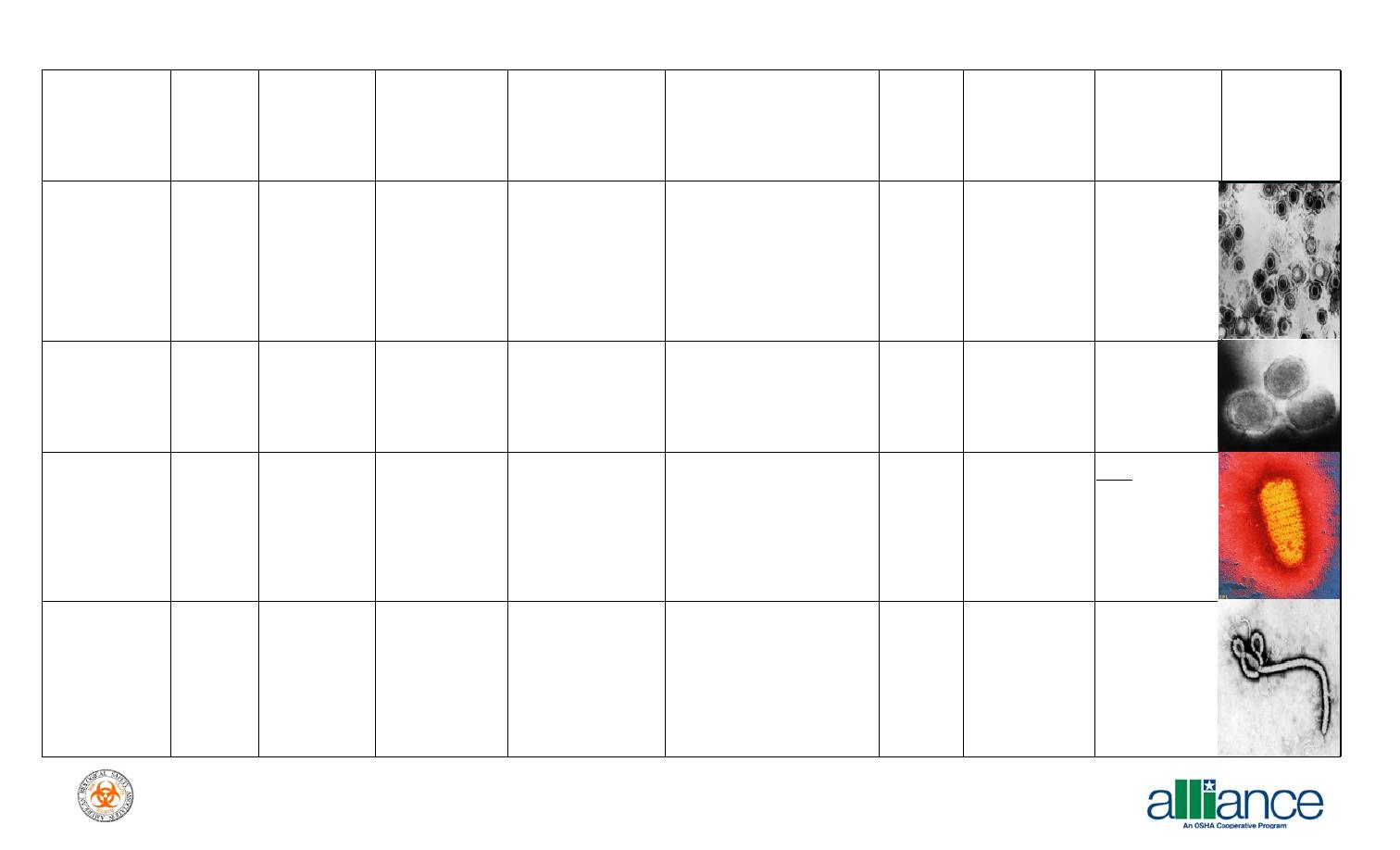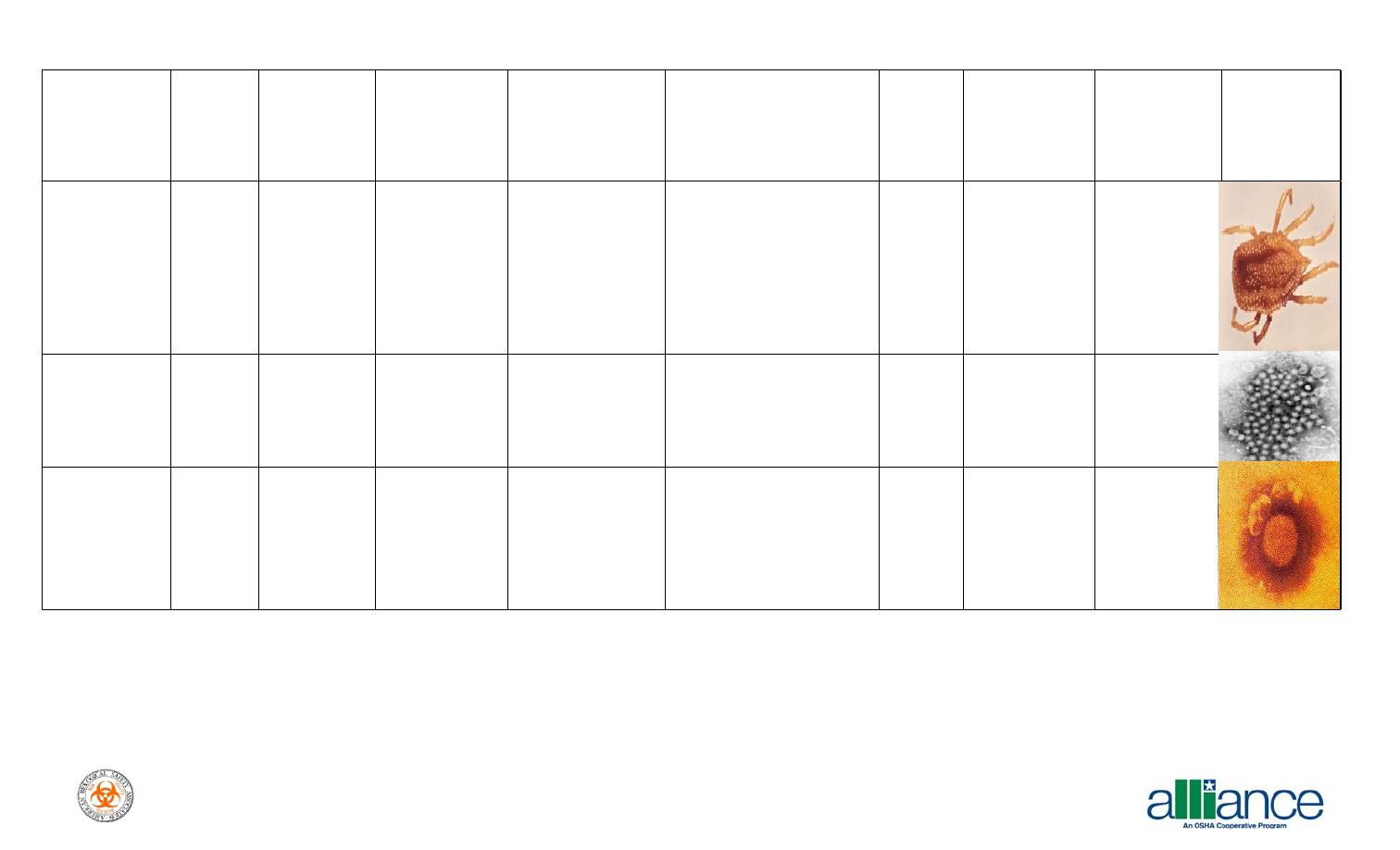
ZOONOTIC DISEASES FACT SHEET
Di
se
as
e
Pa
th
og
en
Ge
nu
s
sp
ec
ie
s
Ho
st
R
an
ge
Tra
ns
m
is
si
on
Sy
m
pto
ms
In
cu
ba
tio
n
Fa
ct
Tre
at
m
en
t
Pho
to
Brucellosis*
Bacteria
Brucella (B.
melitensis, B.
abortus, B. suis, B.
canis )
Infected animals
(swine, cattle, goats,
sheep, dogs)
Skin or mucous membrane
contact with infected
animals, their blood, tissue,
and other body fluids
High and protracted (extended) fever.
Infection affects bone, heart,
gallbladder, kidney, spleen, and
causes highly disseminated lesions
and abscess
1-15 weeks
Most commonly
reported U.S.
laboratory-associated
bacterial infection in
man
Antibiotic
combination:
streptomycina,
tetracycline, and
sulfonamides
Salmonellosis
Bacteria
Salmonella (S.
cholera-suis, S.
enteriditis, S.
typhymurium, S.
typhi)
Domestic (dogs, cats,
monkeys, rodents,
labor-atory rodents,
rep-tiles [especially
turtles], chickens and
fish) and herd animals
(cattle, chickens, pigs)
Direct contact as well as
indirect consumption
(eggs, food vehicles using
eggs, etc.). Human to
human transmission also
possible
Mild gastroenteritiis (diarrhea) to high
fever, severe headache, and spleen
enlargement. May lead to focal
infection in any organ or tissue of the
body)
6 hours to 3
days
Fatality rate of 5-10%
Antibiotic
combination:
chloramphenicol,
neomycin, ampicillin
Shigellosis*
Bacteria
All Shigella species Captive non-human
primates
Oral-fecal route
Ranges from asymptomatic carrier to
severe bacillary dysentery with high
fevers, weakness, severe abdominal
cramps, prostration, edema of the
face and neck, and diarrhea with
blood, mucous and inflammatory
cells
Varies by
species. 16
hours to 7
days.
Highly infective. Low
number of organisms
capable of causing
infec-tion. Rate of
infection in im-ported
monkeys can be high
Intravenous fluids
and electrolytes,
Antibiotics: ampicillin,
amoxicillin,
trimethoprin-
sulfamethoxazole
Leptospirosis
Bacteria
Leptospira
interrogans
Animal, human urine
Direct contact with urine of
infected dogs, mice or rats.
Indirect contact with urine
contaminated materials.
Droplet transmission via
aerosols of urine
Phase 1: headache, muscle ache,
eye pain with bright lights, chills and
fever. Phase 2: fever with stiffness of
the neck and inflammation of the
nerves to the eyes, brain, spinal
column
7-12 Days
Leptospirosis
associated with liver
and kidney disease is
called Weil's
syndrome,
characterized by
jaundice
Doxycycline and
penicillin. Severely ill
patients may need IV
fluids, antibiotics and
dialysis
Through OSHA's Alliance Program,
this fact sheet was developed as a product of the OSHA and ABSA Alliance for informational purposes only.
It does not necessarily reflect the official views of OSHA or the US Dept. of Labor

ZOONOTIC DISEASES FACT SHEET
Di
se
as
e
Pa
th
og
en
Ge
nu
s
sp
ec
ie
s
Ho
st
R
an
ge
Tra
ns
m
is
si
on
Sy
m
pto
ms
In
cu
ba
tio
n
Fa
ct
Tre
at
m
en
t
Pho
to
Relapsing fever
Bacteria
Borreliae spp. [B.
recurrentis (louse-
borne), B. hemsii
(tick-borne)]
Animals
Tick-borne, blood
transfusions
Fever, headache and muscle pain
that lasts 4-10 days and subsides.
Afebrile period lasting 5-6 days
followed by a recurrence of acute
symptoms
5-15 days
Epidemic relapsing
fever (transmitted by
lice) is more severe
than endemic
relapsing fever
(transmitted by ticks)
Tetracyclines,
chloramphenicol
Tuberculosis
Bacteria
Mycobacterium
tuberculosis
Primarily humans,
cattle, non-human
primates, other
animals (rodents)
Inhalation of aerosol
droplets, contaminated
equipment, bites
Ranges from fever and fatigue to
chronic pulmonary disease (fatal).
Lungs, kidney, vasculature (affects all
parts of body)
2-5 weeks
Multidrug-resistant TB
(MDR TB) is an
infection resistant to at
least two first-line anti-
TB drugs, isoniazid
and rifampicin
Isoniazid, rifampin,
streptomycin, and
ethambutol
Melioidosis*
Bacteria
Burkholderia
pseudomallei
( formerly
Pseudomonas
pseudomallei )
Equines, especially
horses and mules;
humans are accidental
hosts
Transmitted by inhaling
dust contaminated by the
bacteria and when
contaminated soil comes in
contact with abraded skin
Cholera-like symptoms (fever, chills,
prostration). Skin lesions, swollen
lymph glands, abscesses septicemia
or pneumonia
2-4 days
Relatively uncommon
disease for humans,
but when left
untreated, has 95%
fatality rate
Chloramphenicol,
doxycycline,
sulfisoxazole, or
cotrimoxazole. IV
chloramphenicol for
bacteremia
Tularemia*
Bacteria
Francisella
tularensis
Isolated from 100
species of wild
animals (e.g., rabbits,
skunk), 9 domestic
mammals, 25 species
of birds, frogs, and
reptiles
Arthropods, direct or
indirect contact, ingestion
of contaminated meats,
inhalation of dust, materials
contaminated with urine,
feces or tissues, bites and
scratches
High fever, chills, headache, focal
ulcers, swollen lymph nodes
1-10 days
Bacterium formerly
known as Pasteurella
tularensis
Streptomycin,
tetracycline
Through OSHA's Alliance Program,
this fact sheet was developed as a product of the OSHA and ABSA Alliance for informational purposes only.
It does not necessarily reflect the official views of OSHA or the US Dept. of Labor

ZOONOTIC DISEASES FACT SHEET
Di
se
as
e
Pa
th
og
en
Ge
nu
s
sp
ec
ie
s
Ho
st
R
an
ge
Tra
ns
m
is
si
on
Sy
m
pto
ms
In
cu
ba
tio
n
Fa
ct
Tre
at
m
en
t
Pho
to
Herpesvirus
Virus
Herpesvirus Type 1
(fever blister, cold
sore) and Type 2
(genital herpes),
Herpesvirus
hominis, Herpes
simiae (Herpes B)
Human, non-human
primates
Produce latent infections in
host and frequently shed
without overt lesions
Frequently asymptomatic. May have
vesicular lesions, neurological or flu-
like symptoms
5 days to 1
month
Herpes simiae is 100%
fatal if untreated;
Herpes Types 1 and 2
are not fatal but cause
chronic infection from
recurrences
Acyclovir or
valcyclovir will arrest
the virus but will not
eliminate virus from
the host
Poxvirus*
Virus
Monkeypox,
vaccinia, cowpox,
buffalopox,
cantagalo, and
aracatuba viruses
Non-human primates,
swine, cattle, horses,
birds
Direct skin contact with
lesions on infected animals
Localized lesions, rash, fever, sore
throat, malaise, encephalitis
Generally: 5-
10 days after
infection
Poxviruses are the
largest and most
complex viruses
smallpox vaccine,
cidofovir, and
vaccinia immune
globulin (VIG)
Rabies Virus
Virus
Rhabdoviridae,
genus Lyssavirus
Natural reservoir: bats.
All mammals: wild
animals (raccoons,
rodents, foxes, etc.)
domestic animals
(dogs, cats) and
humans
Animal bite, contact with
infected saliva or tissue
Headache, fever, malaise,
nervousness, dilation of pupils,
salivation, excessive perspiration,
insomnia, paralysis of throat
muscles, inability to swallow,
convulsions, seizures, generalized
paralysis and death
3-8 weeks
Untreated, the fatality
rate is 100%; Post-
exposure treatment is
effective until day 6
post-infection
Antirabies vaccine
before clinical onset
of symptoms; post-
exposure treatment
with rabies immune
globulin & vaccine
Viral Hemorrhagic
Fever*
Virus
Multiple species:
Filoviridae ; Ebola
virus, Lassa virus,
Marburg virus
Humans, non-human
primates
(Cynomolgous
monkeys)
Contact with blood and
body fluids of infected
animals
Severe fever, sore throat, cough,
diarrhea, vomiting, hemorrhage and
death
2-21 days (5 -
12 days in
most cases)
50-90% fatality rate for
Ebola virus; 25%
mortality rate for
Marburg virus; 15-20%
mortality for Lassa
fever virus
No vaccines; Treat-
ment directed at
maintaining renal
function, electrolyte
balance and
combating
hemorrhage and
shock
Through OSHA's Alliance Program,
this fact sheet was developed as a product of the OSHA and ABSA Alliance for informational purposes only.
It does not necessarily reflect the official views of OSHA or the US Dept. of Labor

ZOONOTIC DISEASES FACT SHEET
Di
se
as
e
Pa
th
og
en
Ge
nu
s
sp
ec
ie
s
Ho
st
R
an
ge
Tra
ns
m
is
si
on
Sy
m
pto
ms
In
cu
ba
tio
n
Fa
ct
Tre
at
m
en
t
Pho
to
Arboviral
infections*
Virus
Multiple species:
Togaviridae,
Flaviviridae,
Bunyaviridae,
Arenaviridae
Ticks, insects, infected
animals (deer, birds,
rodents, etc.)
Ticks, insects, blood
transfusion
Various: viremia, lymphadenapothy
leading to systemic infection. Can
involve CNS (encephalitis), skin/bone
marrow/blood vessels (hemorrhagic
fevers)
Mulltiple
Ranges; 14-25
days (Avg. 18
days) post
infection
Causes: Rift Valley
fever, Denque fever,
Yellow fever; Sandfly
(Hantavirus) fever;
Omsk hemorrhagic
fever, and West Nile
virus infections
No vaccines for most
(except yellow fever
virus), no known
antivirals; supportive
treatment only
Viral Hepatitis
Virus
Hepatitis A, B, C, D
(delta), E, F, G
Humans, non-human
primates (chimpanzee,
wooly monkey, gorilla,
Celebes ape, some
marmosets
Close contact with infected
animals or materials
Fever, anorexia, vague abdominal
discomfort, nausea and vomiting,
sometimes arthralgias and rash,
often progressing to jaundice; fever
may be absent or mild
3-6 weeks
Hepatitis A has no
carrier state; Hepatitis
B 20% chronic;
Hepatitis C 85%
chronic
Vaccines for Hepatitis
A and B only.
Treatment with alpha
inter-feron and intra-
venous immuno-
globulins (HBIG)
Lymphocytic
Choriomeningitis
(LCM)
Virus
Multiple
arenaviruses
Rodents (hamsters,
mice, guinea pigs),
monkeys and humans
Infected mice excrete virus
in saliva, urine and feces;
man infected through
inhalation of aerosolized
particles of (urine, feces or
saliva) contaminated with
virus
Biphasic febrile illness, mild influenza
like illness or occasionally meningeal
or meningoencephalomyelitic
symptoms, transverse myelitis
15-21 days
46 documented
laboratory-acquired
cases with 5 deaths;
cases also reported
arising from
contaminated cell
lines
No specific treatment;
anti-inflammatory
drugs may be useful;
No known vaccines
Through OSHA's Alliance Program,
this fact sheet was developed as a product of the OSHA and ABSA Alliance for informational purposes only.
It does not necessarily reflect the official views of OSHA or the US Dept. of Labor

ZOONOTIC DISEASES FACT SHEET
Di
se
as
e
Pa
th
og
en
Ge
nu
s
sp
ec
ie
s
Ho
st
R
an
ge
Tra
ns
m
is
si
on
Sy
m
pto
ms
In
cu
ba
tio
n
Fa
ct
Tre
at
m
en
t
Pho
to
Vesicular
Stomatitis*
Virus
Multiple strains of
Vesicular Stomatitis
Virus (VSV)
Rhabdoviridiae
Bovine, equine,
porcine animals.
Probably arthropod-borne
via the bite of an infected
sandfly, mosquito or
blackfly; by direct contact
with infected animals
(vesicular fluid, saliva)
Infuenza-like illness, malaise, fever,
headache, nausea and vomiting
24-48 hours
Documented hazard to
personnel (45
laboratory-acquired
infections before 1980)
handling infected
livestock, tissues and
virulent isolates
Virus is self-limiting
and illness is short in
duration. (3-6 days)
Sub-viral Agents
and Related
Diseases (i.e.,
Scrapie)*
non-RNA/DNA
Infectious
Protein Virus-
like particle
Transmissable
Spongiform
Encephalopathies
(TSE): BSE and
vCJD (vCreutzfeld-
Jacob Disease)
Adult sheep goats, and
cows can infect
humans
Ingeston or handling of
brain tissue or unfixed
brain cells from infected
animals
Degeneration of the nervous system,
severe variable alteration of the grey
matter of the brain
2-5 years
The agent responsible
for TSE's is smaller
than the smallest
known virus and has
not been completely
characterized
There are no known
treatments or
vaccines for these
TSE's
Amoebic Dysentery
Parasite
(protozoa)
Entamoeba
histolytica
Monkeys can readily
transmit the agent to
humans
Food, water, fomites,
insects. Fecal-oral route.
Cyst is resistant to drying
Frequent passage of feces/stool,
loose stools and vomiting. Variations
depending on parasites. Can be
frequent urge with high or low
volume of stool, with or without some
associated mucus and even blood
2 days to
several
months to
even years
Harmless amoebas
can live in the in-
testines for years
without causing
symptoms. Attacks
can last from a few
days to weeks
Antiamebic drugs
(Iodoquinol,
metronidazole) and
antibiotics to treat any
associated bacterial
infections
Giardiasis
Parasite
(protozoa)
Giardia lamblia
Dogs, monkeys
Drinking contaminated
water, person-to-person
contact, eating
contaminated food, and
direct contact with infected
animals
Ranges from asymptomatic to
nausea, fatigue, anorexia, severe
diarrhea and high fever
3-25 days
Most common
waterborne diarrheal
disease in humans
Quinacrine
hydrochloride,
metronidazole,
tinidazole,
albendazole and
furazolidone
Through OSHA's Alliance Program,
this fact sheet was developed as a product of the OSHA and ABSA Alliance for informational purposes only.
It does not necessarily reflect the official views of OSHA or the US Dept. of Labor

ZOONOTIC DISEASES FACT SHEET
Di
se
as
e
Pa
th
og
en
Ge
nu
s
sp
ec
ie
s
Ho
st
R
an
ge
Tra
ns
m
is
si
on
Sy
m
pto
ms
In
cu
ba
tio
n
Fa
ct
Tre
at
m
en
t
Pho
to
Balantadidiasis
Parasite
(protozoa)
Balantidium coli
Monkeys, pigs, and
other nonhuman
primates readily
transmitted to humans
Direct contact with feces,
person-to-person
transmission
Ranges from asymptomatic to severe
diarrhea
4-5 days
Cysts survive for long
periods in the
environment
Tetracycline,
Iodoquinol,
metronidazole
Malaria
Parasite
(protozoa)
Plasmodium
species: P.
falciparum
P. vivax
P. ovale
P. malariae
Anopheles mosquito
Mosquito bite
Fever, chills sweating, headache,
nausea, vomiting, muscle pain,
anemia, bloody stools, jaundice,
convulsion, coma
10 days to 4
weeks after
infection;
symptoms
then cycle
every 48 days
A malaria vaccine has
been developed and is
being tested in Africa.
Results are promising
Chloroquine,
primaquine
phosphate, Malorone
Toxoplasmosis
Parasite
(protozoa)
Toxoplasma gondii Amazing lack of host
specificity. Primates,
carnivores (felines),
rodents, birds,
undulates
Consuming under-cooked
infected meats; ingestion
of oocysts in milk, food or
water; inhalation of
oocysts;-contact with soil
containing contaminated
cat feces;
Localized lymphadenopathy
accompanied with fever, sore throat,
rash, pneumonitis, myocarditis, and
encephalitis
10-23 days
following
ingestion of
contamin-ated
meats, or
inhalation of
aerosols
Affects one third of the
human race.
Especially infective to
immunosupressed
individuals
Sulfonomides
(sulfadiazene,
sulfamerazine,
sulfamethazine),
pyrimethamine
Ascariasis
(Roundworm)
Nematode
Multiple Ascaris
species (A.
lumbricoides, A.
suum )
Pigs; Humans are the
definitive host
Ingestion of contaminated
food or water
Lung damage, intestinal symptoms
4 to 8 weeks
Ascaris
lumbricoidesis the
largest and, globally,
the most widespread
of all human intestinal
roundworms
Pyrantel pamoate,
mebendazole, surgery
for removal in lung
tissue
Through OSHA's Alliance Program,
this fact sheet was developed as a product of the OSHA and ABSA Alliance for informational purposes only.
It does not necessarily reflect the official views of OSHA or the US Dept. of Labor

ZOONOTIC DISEASES FACT SHEET
Di
se
as
e
Pa
th
og
en
Ge
nu
s
sp
ec
ie
s
Ho
st
R
an
ge
Tra
ns
m
is
si
on
Sy
m
pto
ms
In
cu
ba
tio
n
Fa
ct
Tre
at
m
en
t
Pho
to
Visceral Larval
Migrans (VLM)
Nematode
Nematodes of the
Toxocara genus (T.
canis, T. felis )
Dogs, cats
Ingestion of eggs through
direct contact with feces or
contaminated materials
Fever, cough, wheezing,
itching/irritation associated with
migration of nematodes into tissues.
Ocular migration may cause
blindness
4 to 7 weeks
More than 80% of all
puppies in the U.S. are
infected with this
nematode
Usually a self-limiting
disease--treatment
only given in severe
cases
(glucocorticoids and
bronchodilators for
pulmonary disease)
Strongyloidiasis
Nematode
Strongyloides
stercoralis
Dogs, cats, monkeys
Careless handling of
contaminated fecal
materials
Abdominal pain, diarrhea, and rash.
Less commonly, nausea, vomiting,
weight loss and cough. Severe
infection can cause severe tissue
damage, systemic damage of various
tissues in the body and potential
death
skin 7 hours;
lung 1 week;
intestines 2
wks; average
4-21 days
The parasite
penetrates the skin
and migrates to the
lungs. Then it travels
up to the mouth and is
swallowed into the
intestinal tract
Ivermectin with
Albendazole as the
alternative
Trichinosis
Nematode
Trichinella spiralis
Generally pigs or cattle Eating undercooked flesh
of animals infected with the
larvae
Nausea, vomiting, diarrhea, fever,
neurological disorders, possible
cardiac involvement
Abdominal
symptoms: 1-
2 days.
Further
symptoms 2-8
weeks after
infection
Over 100 species of
animals may be a host
of this parasite
Thiabendazole
(Mintezol),
Albendazole
(Albenza),
Mebendazole
(Vermox), Prednisone
*Images were obtained from the U.S. Centers for Disease Control & Prevention Public Health Image Library (PHIL). 08/2008
Through OSHA's Alliance Program,
this fact sheet was developed as a product of the OSHA and ABSA Alliance for informational purposes only.
It does not necessarily reflect the official views of OSHA or the US Dept. of Labor
